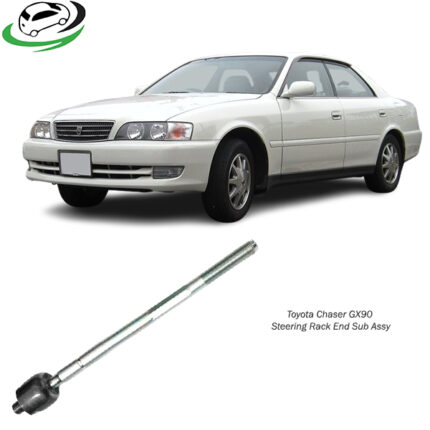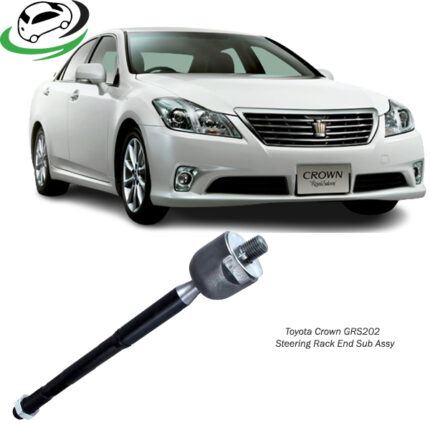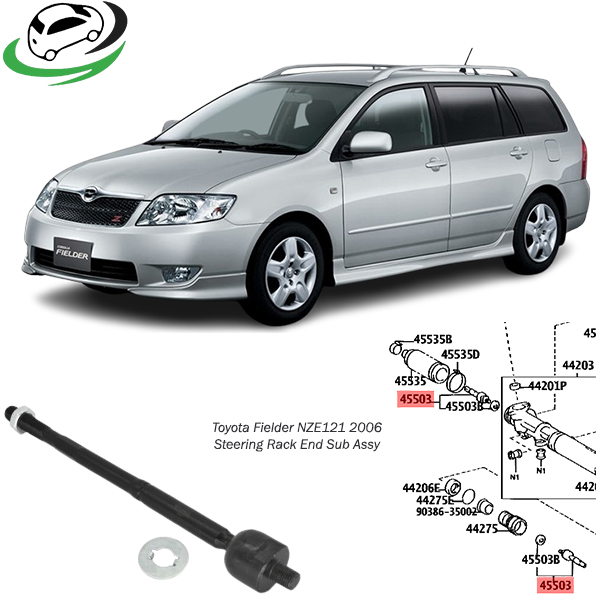-17%
Get Toyota Fielder NZE121 2006 Steering Rack End Sub Assy 45503-19255 IN Kenya
The Steering Rack End Sub Assembly, or simply the “rack end,” is an essential part of a vehicle’s steering mechanism, responsible for translating driver input from the steering wheel to the wheels, enabling smooth directional control. Found in rack-and-pinion steering systems, the rack end contributes to the overall handling, responsiveness, and alignment of a vehicle. This detailed look at the steering rack end will explore its structure, function, types, maintenance, replacement, and the signs of potential issues.
1. Understanding the Steering Rack End
The steering rack end is located at the end of the steering rack and links to the tie rod ends. Together, they form the connection between the steering gear (which translates the driver’s steering input) and the wheels, transferring motion from the steering wheel to guide the vehicle’s direction. It’s essential for vehicle stability, providing precise feedback and facilitating smooth turns.
In a typical rack-and-pinion steering system, the steering wheel is connected to a shaft, which interacts with the steering gear. When the steering wheel is turned, the steering gear engages with the rack, and the rack ends, connecting to the tie rods, push the wheels to steer the car.
2. Key Components of the Steering Rack End Assembly
The steering rack end sub assembly contains several components, each vital for its operation:
- Inner Tie Rod: This connects the rack to the outer tie rod, forming the main connection point for the motion transfer from the steering rack to the steering knuckle.
- Ball Joint: The ball joint within the rack end allows for pivoting and ensures flexibility for the movement between the steering mechanism and the wheels. The joint enables free rotational movement, allowing the wheels to respond accurately to the driver’s steering input.
- Dust Boot: A rubber boot, also known as a dust boot or gaiter, encases the inner tie rod to protect it from dirt, debris, and moisture, all of which can cause wear over time.
- Rack End Housing: This component secures the inner tie rod in place while allowing the ball joint to pivot freely. The housing is usually made from durable materials like hardened steel or aluminum for longevity and strength.
3. Functions of the Steering Rack End Sub Assembly
The steering rack end assembly has multiple roles, contributing to overall steering efficiency:
- Steering Control: It plays a central role in converting the rotational movement of the steering wheel into linear movement, allowing the wheels to steer in the intended direction.
- Stabilization: By securing the inner tie rod, the rack end provides stability and ensures that steering inputs result in precise vehicle movements.
- Suspension Compliance: The rack end accommodates slight adjustments in wheel alignment due to suspension movement, ensuring a consistent ride quality and improved handling.
4. Types of Steering Rack Ends
Rack ends can vary slightly depending on the vehicle and steering setup:
- Fixed Rack Ends: In most vehicles, rack ends are designed with a fixed length to provide straightforward alignment with the steering gear and wheels.
- Adjustable Rack Ends: Some aftermarket rack ends offer adjustability features, which can be useful for custom alignment settings, especially in performance and off-road vehicles.
5. Importance of the Steering Rack End in Vehicle Performance
The steering rack end is vital for several reasons:
- Vehicle Safety: A well-functioning rack end ensures proper wheel alignment and stability, minimizing the risk of poor steering control and accidental lane drifting.
- Reduced Tire Wear: Proper alignment and steering control lead to even tire wear. A failing rack end can cause uneven tire wear, which shortens tire lifespan and affects vehicle handling.
- Driving Comfort: Without a well-functioning rack end, drivers may experience vibrations, looseness in the steering wheel, and discomfort, particularly when navigating corners or rough surfaces.
- Improved Responsiveness: High-quality rack ends enable quick and precise steering responses, which are especially important for performance vehicles.
6. Symptoms of a Failing Steering Rack End
Regular inspection is essential, as a failing steering rack end can lead to unsafe driving conditions. Common signs of a malfunctioning or worn rack end include:
- Loose Steering Wheel: If the steering feels loose or “play” can be felt in the steering wheel, it might indicate wear in the ball joint or tie rod connection.
- Steering Wheel Vibrations: Vibrations while driving, especially on rough roads, can be a symptom of a failing rack end that cannot absorb impacts effectively.
- Clunking or Knocking Noises: Unusual sounds when turning, especially at low speeds, can indicate wear in the ball joint or an issue with the rack end connection.
- Uneven Tire Wear: Misalignment caused by a damaged or failing rack end can cause uneven tire wear, leading to reduced tire life.
- Vehicle Pulling to One Side: A damaged rack end can cause the vehicle to drift or pull to one side, affecting the vehicle’s alignment and handling.
7. Maintenance of Steering Rack Ends
To extend the lifespan and maintain the efficiency of a rack end, routine maintenance is recommended:
- Inspect Regularly: A visual inspection of the rack end, dust boot, and tie rods can help detect early signs of wear or damage. Check for cracks, tears, or oil leaks around the dust boot, as these can signal deterioration.
- Monitor Wheel Alignment: Regularly scheduled alignment checks can help ensure the steering rack and rack ends remain in optimal condition. Misalignment can lead to accelerated wear on the rack end.
- Lubrication: Rack ends often come pre-lubricated, but if maintenance is required, ensure they are adequately lubricated to prevent friction, which can cause early wear.
- Replace Dust Boots: Damaged dust boots expose the rack end and tie rods to debris and moisture, causing rust and wear. Ensure boots are in good condition and replace them when necessary.
8. Replacing the Steering Rack End
If you suspect a failing rack end, timely replacement is essential for safe vehicle operation. Here’s an overview of the replacement process:
- Preparation: Lift the vehicle safely and remove the wheel to access the steering linkage.
- Remove the Outer Tie Rod: Loosen the lock nut on the tie rod, then remove the outer tie rod from the knuckle.
- Separate the Inner Tie Rod: Use a special tool to remove the inner tie rod from the steering rack.
- Install New Rack End: Place the new rack end in position, securing it to the steering rack, and tighten to the manufacturer’s specifications.
- Reassemble and Align: Reattach the outer tie rod and tighten all components securely. It’s essential to get an alignment check to ensure proper wheel alignment post-replacement.
9. Cost and Considerations for Replacement
The cost of replacing a steering rack end depends on several factors:
- Vehicle Make and Model: Some vehicles have more complex steering systems, which may require more expensive parts or specialized labor.
- OEM vs. Aftermarket: OEM parts are often more costly but ensure compatibility, whereas aftermarket options provide similar functionality at a potentially lower price.
- Labor Costs: Labor rates vary by region and mechanic, but replacing a rack end typically requires about an hour of labor.
In general, expect a cost range of $50 to $150 per tie rod end, with labor adding an additional $80 to $200 depending on the shop.
10. Conclusion
The steering rack end sub assembly is a small yet vital component of a vehicle’s steering system. From precise handling and smooth steering responses to the reduction of tire wear, the rack end plays a pivotal role in safe driving. Regular inspection, timely maintenance, and proper replacement are key to ensuring the vehicle’s handling remains responsive and safe.
Follow us on Facebook for more parts.



